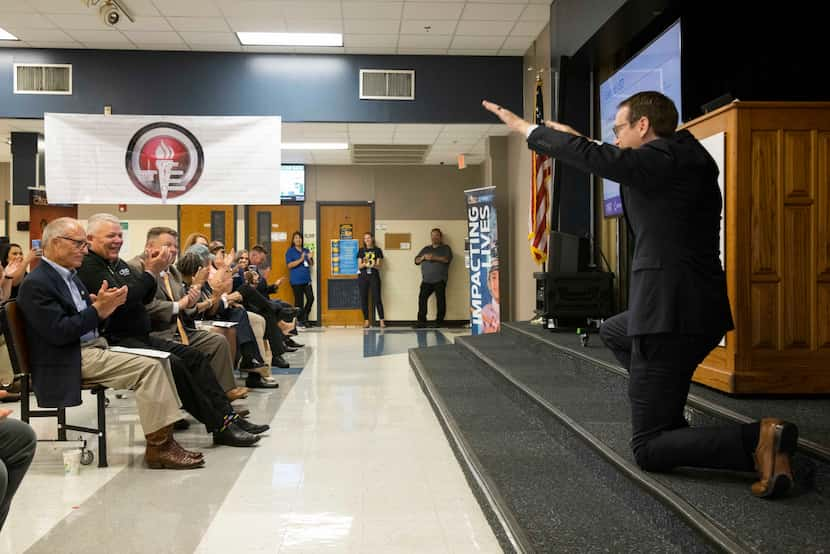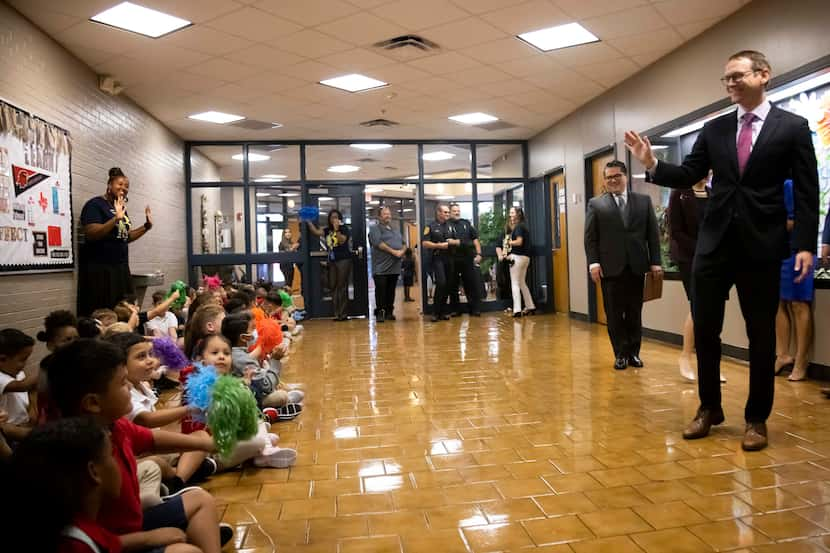More Texas schools earned high marks from the state this year than prior to the pandemic, another welcome sign pointing to students’ academic momentum as they head back to class.
Nearly three-quarters of Texas schools earned an A or B in the state’s academic accountability rating system. In 2019, roughly 60% of schools earned that designation.
Dallas earned a B rating, as did other large local districts, including Fort Worth and Plano. Among the local districts earning the top A grade were Frisco, Coppell and Highland Park.
“Even with all of the disruptions of the pandemic, we’ve seen significant gains, especially in academic growth,” Texas education commissioner Mike Morath said.
No schools received a failing grade. Instead, those that would have earned the lowest marks — a D or F grade — are listed as “not rated” as the Texas Education Agency acknowledges the lingering impact of COVID-19 on schools.
The only local district not rated was Lake Worth. The district, located just north of Fort Worth, earned a 67 as its overall score.
Of the nearly 8,500 campuses graded, 7% did not earn a rating. In a typical year, that could expose them to consequences. If a school or district receives enough consecutive failing grades, the state can decide to close a campus or intervene in a district.
Between 2019 and this year, one-third of campuses improved their letter grade while 15% declined.
This is the first time since the pandemic hit that families will get a glimpse of how their campuses fared in the A-F accountability system. Gov. Greg Abbott canceled both the State of Texas Assessment of Academic Readiness, or STAAR, exams and school ratings in 2020 soon after campuses closed.
The accountability system, largely based on STAAR results, takes into account three major categories: student achievement, school progress and closing the gaps.
Student achievement is mostly determined by STAAR scores. School progress includes how much improvement they made on the tests from one year to the next or how well they did in relation to comparable campuses. “Closing the gaps” looks at how well schools do educating children in different subgroups, such as those living in poverty, enrolled in special education or of various races.
Seventy percent of a grade is based on either student achievement or school progress — whichever is the higher grade — while closing the gaps makes up 30%.
Nearly half of schools saw their highest score in the growth domain, compared with 17% in 2019.
“More kids are growing in a year’s time than historically has been the case,” Morath said. “If we can sustain, that’s like a higher rate of compound interest.”
Morath acknowledged that a campus may earn a high grade, even if students overall scored poorly on STAAR, as long as it made progress over last year. But if a school ends up with strong progress year over year, he said, they ultimately “will not end up with low levels of achievement.”
Texas has largely been unsuccessful in previous attempts to help kids who have fallen behind catch up. On average, only 4% of all of the state’s students — across all grades and subjects — who are below grade level catch up to grade level within two years, a pre-pandemic study found.
The state has long trailed in national measures of student progress.
Morath attributed this year’s accelerated growth to several state policies, including legislatively mandated tutoring and Reading Academies, which require that certain teachers study the science behind how children learn to read.
He said the agency is working on an analysis to prove whether districts that embraced those strategies saw major growth, but it does not yet have that information prepared.
“We’re getting a bunch of very strong anecdotal reports back,” he said.
Local results
Dallas trustees reviewed preliminary data Thursday showing the district will maintain its B rating.
“We’ve got work to do, no denying that,” trustee Joe Carreón said. But he added that he was heartened by the number of campuses that moved up a letter.
“To any principal who watches this later or teacher who can hear my voice later, thank you so much,” Carreón said.
Of Dallas ISD’s more than 220 schools, 26 — many of them magnets or early college programs — earned an A, but nearly two dozen weren’t rated at all. The remaining schools earned a B or a C.
One of the Dallas schools that did not earn a rating was Frederick Douglass Elementary, which was part of the district’s signature school turnaround — ACE — program last year.
After earning a C in 2019, Fort Worth school leaders celebrated moving up to a B. That district’s longtime superintendent Kent Scribner is stepping down soon, and trustees have narrowed down finalists, according to the Fort Worth Star-Telegram.
Almost every district in Dallas, Collin, Denton and Tarrant counties scored at least a C.
The majority of school districts in Dallas County garnered a B, including Mesquite, Grand Prairie and Garland. DeSoto ISD — which remains under a state conservatorship after financial woes and leadership troubles — moved up to a B. Cedar Hill ISD was the lone district in the county to receive a C.
Cedar Hill spokesman Michael Sudhalter said the district has “already begun rolling up its sleeves to improve quickly.”
“The grade doesn’t define who we are as a district, but it does provide learning opportunities and soul searching as the district moves forward,” he said in a statement. “This is not the time to retreat, but rather to reinvest in CHISD educators, who are committed to scholar success.”
Sunnyvale joined Highland Park and Coppell in earning an A. Collin County school districts earning an A include Allen, Prosper and Wylie. Those that received a B include McKinney, Anna and Plano, which missed out on an A by one point.
Tarrant County districts receiving the top marks include Grapevine-Colleyville, Hurst-Euless-Bedford and Southlake Carroll.
Schools had millions of extra federal dollars available to them this year to support academic acceleration. They funneled that pandemic aid toward extra tutors, longer school days and other high-cost interventions.
Superintendents must evaluate what strategies actually yielded results for kids and figure out how to keep them going, particularly after the money runs out.
Mesquite superintendent Ángel Rivera said his district — like others — is examining results and efforts to figure out what is actually generating gains. When the time runs out, he said, they’ll ask themselves: “Where are we going to prioritize our local funding?”
Morath celebrated Back Elementary’s grade bump on Monday. The Garland school jumped from a low B before the pandemic to an A this year.
The commissioner praised teachers and staff for doing the hard work of catching kids up after the pandemic hit. Strategies like mandated tutoring for struggling students aren’t easy, he said, but bear real fruit for children.
At one point, Morath got on his knees and bowed toward the Back Elementary staff.
“For the kids who were struggling the most, they got more specific attention in the last year than perhaps ever before,” he said. “That’s not easy to do.”

Poverty as predictor
Some superintendents have long argued that the A-F accountability system oversimplifies education and stigmatizes schools with large numbers of children who live in poverty. A family’s income is often deeply tied to how a child performs on standardized tests.
Districts in poorer areas grapple more with the effects of limited financial resources, trauma and housing instability. And such neighborhoods were hit particularly hard by COVID-19.
Morath pushed back on the idea that the system is merely a measure of poverty. Roughly 18% of all high-poverty campuses in Texas scored a 90 or above.
“Even where almost all of your kids are low-income, we have campuses that are knocking it out of the park that are demonstrating both high levels of growth and high levels of achievement,” Morath said.
But only 21 public schools in Dallas County that serve a student population where 80% or more are from low-income families received an A this year. By comparison, 34 Dallas County schools serving similar student populations weren’t rated at all.
In Tarrant County, 19 high-poverty schools scored a 90 or above, which equates to an A. Another 29 schools didn’t even make a 70, or a C. Only one high-poverty school in Denton County received an A, and none of Collin County’s five high-poverty school campuses earned the top mark.
Supporters of the letter grades say they offer families more transparency about how schools are doing.
“I am a dad,” Morath said. “I use these ratings two ways: I use ratings to advocate for my school to get better, and I use these ratings to evaluate where my kid is, to make sure that I have the best-fit school for my own child.”
The DMN Education Lab deepens the coverage and conversation about urgent education issues critical to the future of North Texas.
The DMN Education Lab is a community-funded journalism initiative, with support from The Beck Group, Bobby and Lottye Lyle, Communities Foundation of Texas, The Dallas Foundation, Dallas Regional Chamber, Deedie Rose, Garrett and Cecilia Boone, The Meadows Foundation, The Murrell Foundation, Solutions Journalism Network, Southern Methodist University, Todd A. Williams Family Foundation and the University of Texas at Dallas. The Dallas Morning News retains full editorial control of the Education Lab’s journalism.



/cloudfront-us-east-1.images.arcpublishing.com/dmn/LXL4CR7EA5D7JI47WONFFLYOGY.jpg)
/cloudfront-us-east-1.images.arcpublishing.com/dmn/UQHTFNAUSVHJZNJCYLRED7PP4I.jpg)
:no_upscale()/cloudfront-us-east-1.images.arcpublishing.com/dmn/UABC4OXZK5AIROU4I4VOMDQ7E4.jpg)
/cloudfront-us-east-1.images.arcpublishing.com/dmn/FYT7SSSW3NDXNCYJU62IXDAXM4.jpg)
/cloudfront-us-east-1.images.arcpublishing.com/dmn/L3TDLBTP2FDALGGQ25M44SGIK4.jpg)